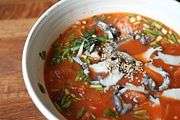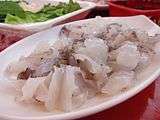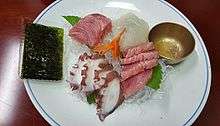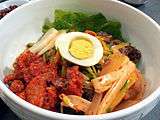Hoe (food)
.jpg) | |
| Type | Raw fish |
|---|---|
| Place of origin | Korea |
| Associated national cuisine | Korean cuisine |
|
| |
| Korean name | |
| Hangul | 회 |
|---|---|
| Hanja | 膾; 鱠 |
| Revised Romanization | hoe |
| McCune–Reischauer | hoe |
| IPA | [hwe̞] |
Hoe (회; 膾/鱠) refers to several varieties of raw food dishes in Korean cuisine.[1]
Varieties
There are uncooked hoe (회) as well as blanched sukhoe (숙회).[2][3]
Raw
Hoe (회), the raw fish or meat dish, can be devided into saengseon-hoe (생선회), filleted raw fish, and yukhoe (육회), sliced raw meat.[4][5] Saengseon-hoe (생선회) can be either hwareo-hoe (활어회) made from freshly killed fish, or seoneo-hoe (선어회) made using aged fish. Mulhoe (물회) is a cold raw fish soup.[6]
- Baemjangeo-hoe (뱀장어회) – freshwater eel
- Baendaengi-hoe (밴댕이회) – sardinella
- Bangeo-hoe (방어회) – amberjack
- Bungeo-hoe (붕어회) – Crucian carp
- Daegu-hoe (대구회) – cod
- Dorumuk-hoe (도루묵회) – sandfish
- Gajami-hoe (가자미회) – righteye flounder
- Gamulchi-hoe (가물치회) – snakehead
- Gehoe (게회) – crab
- Gul-hoe (굴회) – oyster
- Gwangeo-hoe (광어회) – olive flounder
- Haesam-hoe (해삼회) – sea cucumber
- Hongeo-hoe (홍어회) – skate
- Ingeo-hoe (잉어회) – carp
- Jari-hoe (자리회) – chromis
- Jogae-hoe (조개회) – clam
- Jogi-hoe (조기회) – yellow croaker
- Junchi-hoe (준치회) – ilisha
- Mineo-hoe (민어회) – brown croaker
- Muneo-hoe (문어회) – giant octopus
- Myeongtae-hoe (명태회) – pollock
- Nakji-hoe (낙지회) – long arm octopus
- Nongeo-hoe (농어회) – seabass
- Saengbok-hoe (생복회) – abalone
- San-nakji (산낙지) – long arm octopus
- Ssogari-hoe (쏘가리회) – mandarin fish
- Sungeo-hoe (숭어회) – mullet
Blanched
Sukhoe (숙회) is a blanched fish, seafood, meat, or vegetable dish. Ganghoe (강회) is a dish of rolled and tied ribbons made with blanched vegetables such as water dropworts and scallions.[7]
- Cheonggak-hoe (청각회) – green fleece
- Dureup-hoe (두릅회) – angelica tree shoot
- Gaji-hoe (가지회) – eggplant
- Gosu-ganghoe (고수강회) – coriander
- Hallyeon-ganghoe (한련회) – nasturtium
- Muneo-sukhoe (문어숙회) – giant octopus
- Minari-ganghoe (미나리강회) – water dropwort
- Minari-hoe (미나리회) – water dropwort
- Pa-ganghoe (파강회) – scallion
- Sechong-ganghoe (세총강회) – scallion
- Ssukgat-ganghoe (쑥강회) – mugwort
- Sunchae-hoe (순채회) – water shield
Preparation
Hwareo-hoe (활어회) is prepared by filleting freshly killed fish, while seoneo-hoe (선어회) is made with aged fish in a similar way to prepare Japanese sashimi: removing the blood and innards and ageing the fish at certain temperature before filleting.[8][9] Fish or seafood hoe is often served with gochujang-based dipping sauces, such as cho-gochujang (chili paste mixed with vinegar) and ssamjang (chili paste mixed with soybean paste). Hoe is often eaten wrapped in ssam (wrap) vegetables, such as lettus and perilla leaves. After eating hoe at a restaurant, maeun-tang (spicy fish stew) made with the bones, head, and the remaining meat of the fish, can be served as an add-on dish.
History
 |
| This article is part of a series on |
| Korean cuisine 한국 요리 조선 료리 |
|---|
|
Staples |
|
|
Historians assume the tradition of eating hoe was imported from China to Korea during early in the Three Kingdoms Period (57 BC-668 AD), facilitated by frequent exchanges between China and Korea on the Korean peninsula. According to the Confucian Analects, written in the 1st century BC, Confucius said "Do not shun rice that is well clean; do not shun kuai that is thinly sliced" (食不厭精,膾不厭細).[10] While the term kuai (膾) originally referred to finely sliced raw fish or other meats such as beef or lamb, since the Qing and Han Dynasties it has referred mainly to raw fish.
With the popularization of Buddhism in Korea, beginning in the middle of the Three Kingdoms Period, and running late into the Goryeo Dynasty (918–1392), the consumption of fish and other meat products (including hoe) declined. As the influence of Buddhism waned in the late Goryeo Dynasty period, the consumption of hoe began to lose its stigma.
During the Joseon Dynasty, the state promoted Confucianism, and, as Confucius was known to have enjoyed eating raw meat, hoe consumption greatly increased.[11]
Today, the consumption of raw meat or seafood in Chinese cuisine is rare outside of a few regions, such as Chaozhou where dishes such as yusheng are popular.
Gallery
.jpg) hoe
hoe Various hoe
Various hoe Godeungeo-hoe (raw chub mackerel)
Godeungeo-hoe (raw chub mackerel) Galchi-hoe (raw largehead hairtail)
Galchi-hoe (raw largehead hairtail) Gulhoe (raw oysters)
Gulhoe (raw oysters) Mulhoe (cold hoe soup)
Mulhoe (cold hoe soup) Jeonbok-mulhoe (cold abalone soup)
Jeonbok-mulhoe (cold abalone soup)
 malgogi-yukhoe (horse meat tartare)
malgogi-yukhoe (horse meat tartare) Ojingeo-hoe (raw squid)
Ojingeo-hoe (raw squid) ojingeo-sukhoe (blanched squid)
ojingeo-sukhoe (blanched squid) muneo-sukhoe (blanched octopus)
muneo-sukhoe (blanched octopus) Minari-ganghoe, dropwort rolls
Minari-ganghoe, dropwort rolls Hoe-muchim (seasoned hoe)
Hoe-muchim (seasoned hoe) hoe-naengmyeon (cold noodles with hoe)
hoe-naengmyeon (cold noodles with hoe).jpg) hoe-deopbap (bibimbap with hoe)
hoe-deopbap (bibimbap with hoe)
See also
References
- ↑ Koon, Wee Kek (28 May 2017). "Sushi in Japan? Raw beef in Korea? They got it from China, where Confucius dined on raw venison, boar and fish". South China Morning Post. Retrieved 3 June 2017.
- ↑ "hoe" 회. Standard Korean Language Dictionary (in Korean). National Institute of Korean Language. Retrieved 3 June 2017.
- ↑ "sukhoe" 숙회. Standard Korean Language Dictionary (in Korean). National Institute of Korean Language. Retrieved 3 June 2017.
- ↑ "saengseon-hoe" 생선회. Standard Korean Language Dictionary (in Korean). National Institute of Korean Language. Retrieved 3 June 2017.
- ↑ "yukhoe" 육회. Standard Korean Language Dictionary (in Korean). National Institute of Korean Language. Retrieved 3 June 2017.
- ↑ "mulhoe" 물회. Standard Korean Language Dictionary (in Korean). National Institute of Korean Language. Retrieved 3 June 2017.
- ↑ "ganghoe" 강회. Standard Korean Language Dictionary (in Korean). National Institute of Korean Language. Retrieved 3 June 2017.
- ↑ 김, 경운 (26 October 2015). "[김경운 기자의 맛있는 스토리텔링 15] 선어회와 활어회". Seoul Shinmun (in Korean). Retrieved 3 June 2017.
- ↑ 여성조선 (27 March 2017). "고기와 생선, 숙성의 맛". The Chosun Ilbo (in Korean). Retrieved 3 June 2017.
- ↑ http://www.afpc.asso.fr/wengu/wg/wengu.php?no=248&l=Lunyu
- ↑ Kim Hak-min (김학민) (2003-07-16). 공자 사모님 힘드셨겠네 (in Korean). The Hankyoreh. Retrieved 2008-08-23.
External links
| Wikimedia Commons has media related to Hweh. |
